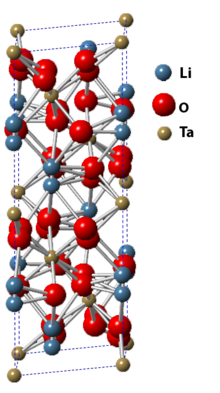Lithium tantalate
 | |
 __ Li+ __ Ta5+ __ O2− | |
| Names | |
|---|---|
| IUPAC name Lithium tantalate | |
| Other names Lithium metatantalate | |
| Identifiers | |
CAS Number |
|
| ECHA InfoCard | 100.031.584 |
PubChem CID |
|
| RTECS number |
|
CompTox Dashboard (EPA) |
|
| Properties | |
Chemical formula | LiTaO3 |
| Molar mass | 235.887 g/mol |
| Density | 7.46 g/cm3, solid |
| Melting point | 1,650 °C (3,000 °F; 1,920 K) |
Solubility in water | Insoluble in water |
| Structure | |
Crystal structure | Space group R3c |
Lattice constant | a = 515.43 pm, c = 1378.35 pm[1] |
| Hazards | |
| Occupational safety and health (OHS/OSH): | |
Main hazards | Acute Toxicity: Oral, Inhalation, Dermal |
| Safety data sheet (SDS) | http://www.samaterials.com/pdf/Lithium-Tantalate-Wafers-(LiTaO3-Wafers)-sds.pdf |
| Related compounds | |
Other anions | LiNbO3 |
| Supplementary data page | |
| Lithium tantalate (data page) | |
Except where otherwise noted, data are given for materials in their standard state (at 25 °C [77 °F], 100 kPa).  Y verify (what is Y verify (what is  Y Y N ?) N ?) Infobox references | |

- Tabletop fusion may lead to neutron source
Lithium tantalate is the inorganic compound with the formula LiTaO3. It is a white, diamagnetic, water-insoluble solid. The compound has the perovskite structure. It has optical, piezoelectric, and pyroelectric properties. Considerable information is available from commercial sources about this material.[2]
Synthesis and processing
Lithium tantalate is produced by treating tantalum(V) oxide with lithium oxide. The use of excess alkali gives water-soluble polyoxotantalates. Single crystals of Lithium tantalate are pulled from the melt using the Czochralski method.[2]
Applications
Lithium tantalate is used for nonlinear optics, passive infrared sensors such as motion detectors, terahertz generation and detection, surface acoustic wave applications, cell phones. Lithium tantalate is a standard detector element in infrared spectrophotometers.[3]
Research
The phenomenon of pyroelectric fusion has been demonstrated using a lithium tantalate crystal producing a large enough charge to generate and accelerate a beam of deuterium nuclei into a deuterated target resulting in the production of a small flux of helium-3 and neutrons through nuclear fusion without extreme heat or pressure.[4]
A difference between positively and negatively charged parts of pyroelectric LiTaO3 crystals was observed when water freezes to them.[5]
See also
- Lithium tantalate (data page)
References
- ^ Abrahams, S.C; Bernstein, J.L (1967). "Ferroelectric lithium tantalate—1. Single crystal X-ray diffraction study at 24°C". Journal of Physics and Chemistry of Solids. 28 (9): 1685. Bibcode:1967JPCS...28.1685A. doi:10.1016/0022-3697(67)90142-4.
- ^ a b Andersson, Klaus; Reichert, Karlheinz; Wolf, Rüdiger (2000). "Tantalum and Tantalum Compounds". Ullmann's Encyclopedia of Industrial Chemistry. doi:10.1002/14356007.a26_071. ISBN 3-527-30673-0.
- ^ "Application note: Infrared Spectroscopy" (PDF).
- ^ B. Naranjo, J.K. Gimzewski & S. Putterman (2005). "Observation of nuclear fusion driven by a pyroelectric crystal". Nature. 434 (7037): 1115–1117. Bibcode:2005Natur.434.1115N. doi:10.1038/nature03575. PMID 15858570. S2CID 4407334.
- ^ D. Ehre; E. Lavert; M. Lahav; I. Lubomirsky (2010). "Water Freezes Differently on Positively and Negatively Charged Surfaces of Pyroelectric Materials". Science. 327 (5966): 672–675. Bibcode:2010Sci...327..672E. doi:10.1126/science.1178085. PMID 20133568. S2CID 206522004.
- v
- t
- e
- TaB2
| Organotantalum(III) |
|---|
- TaS2
- TaSe2
- TaI4
- TaC
- TaTe2
- Ta4HfC5
- TaF5
- TaCl5
- TaBr5
- TaI5
- Ta2O5
- LiTaO3
- NdTaO4
- LuTaO4
- K2TaF7
- H2TaF7
- K2Ta2O3F6
| Organotantalum(V) |
|---|
 | This crystallography-related article is a stub. You can help Wikipedia by expanding it. |
- v
- t
- e












